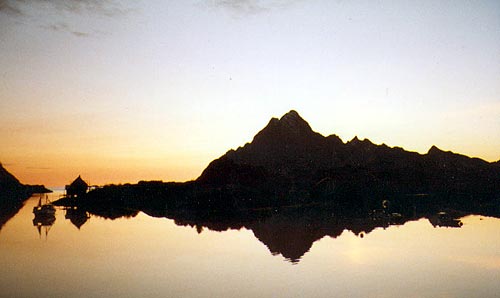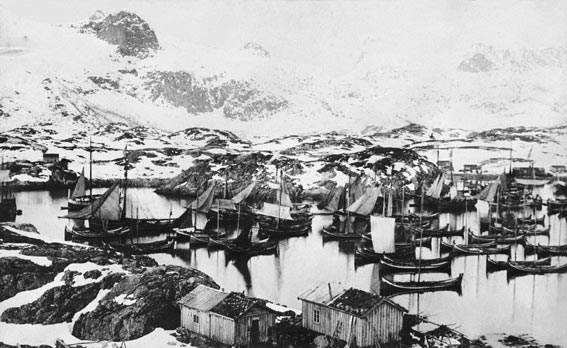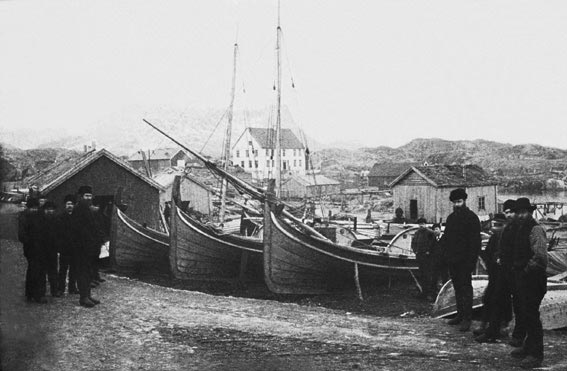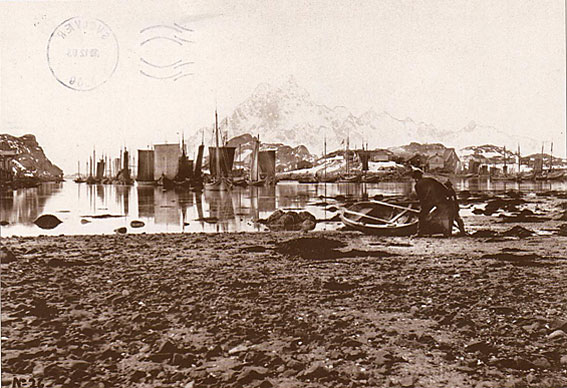Historical
information about KABELVÅG and the old parts of Vågan, Lofoten
- where Lofoten
Fritids Rorbuer is situated.
Enjoy the view, and ponder bygone times.
Kabelvåg, Lofoten (1 km from Lofoten Fritids Rorbuer) is the oldest
fishing village in Lofoten, and it was here that the commercial aspect
of the fisheries was first developed about 1,000 years ago. Fishermen
from all over northern Norway came to the coves and inlets (Vågan)
around Kabelvåg to harvest their share of the cod that migrate here
every year. And Vågan developed into the centre of the medieval region
of Hålogaland. In the grounds of the Lofoten Museum in Storvågan, 1 km
west of Kabelvåg (and a 10 minute walk from the cabins), you will find
the remains of this old centre, formerly known as Vågar.

View from Lofoten Fritids Rorbuer towards Vågar.
Stockfish exports to the Mediterranean formed the basis for Vågan’s
growth and development. Stockfish became a trading commodity around the
year 1000 A.D. To begin with, exports were most likely carried out
directly from Vågan and North Norway to other countries. But gradually,
the stockfish was bought up by merchants who came from the south to buy
fish and sell corn and other essential goods. The stockfish was carried
to Trondheinm and Bergen, and finally only to Bergen, for export. In
this way, the Vågastevnet fair came into being – originally as a market
fair.
But the power of the crown also became intent on exploiting such a large
gathering of people, and gradually a political assembly was established
here. The assembly was established at Brurberget (approx. 200-300m from
the cabins), near Storvågan (view from the cabins) and the most famous
assembly there was held in 1282, when the so-called Vågabok, which was a
special code of laws for Vågan, was revoked. From now on, only the
king’s own laws were to apply. Apparently, Vågan has also had its own
currency, the so-called Vågasølv.
In 1321, Archbishop Eiliv visited Vågan inaugurating an annual assembly
of the clergy, where it was decided that all churches in northern Norway
together with the Archbishop’s See in Nidaros should send
representatives to the annual summer assembly in Vågan. Thus the
complete Vågastevne Assembly was formed:
1) Market fair
2) Political Assembly
3) Clerical Assembly

After the Black Death, Vågan
declined. When bailiff of Lofoten and Vesterålen Erik Hansen Schønnebøl
was here in 1591, he wrote that Vågan, that had once been a market town,
was now nothing more than an impoverished fishing village inhabited only
by “10-12 wretches.”
Later, a new centre arose in Kabelvåg, and towards the end of the 19th
century, Kabelvåg once again had townlike settlement and was without
doubt the “capital” of the Lofoten Islands with its police station,
sheriff’s office, dean and, above all, its trading centre. Another
symbol of Kabelvåg’s important position in Lofoten was its newspapers.
No less than four newspapers were published here at different points in
time and in 1895, three of them were issued at the same time.
Kabelvåg was also one of the more prominent market towns along the
coast. The market had, as we have seen, traditions dating way back in
time. When the first market was staged in 1882, it was a revival of the
old mediaeval Vågastevnet. The sale of stockfish was the predominant
element at the Vågastevnet, but the more recent Kabelvåg Market was more
characterized by amusement and recreation. People came here to buy and
sell, to entertain and to be entertained. The last of these Kabelvåg
Markets was staged in 1939.
With the motorization of the coastal vessels, the importance of Kabelvåg
once again declined. The harbour was not good enough, and Svolvær took
over most of the maritime traffic, and consequently most of the new
growth and development. In spite of the town being ravaged by several
major fires, the time-honoured wooden architecture was still the trade
mark of Kabelvåg. However, with the two most recent fires, on 8 December
1991 and 13 June 1992, practically all of the oldest buildings in the
main street have now been lost.

Today, Kabelvåg is primarily a centre of education and culture and is
the venue for a college of further education, a school of art, a folk
high school and Nordland Video Workshop providing education in the field
of filmmaking.
At Storvågan, 1 km west of Kabelvåg and Lofoten Fritids Rorbuer - and
still within the borders of the old mediaeval centre, there is now a
culture and tourism centre. The Lofoten Regional Museum is located
there, and within its grounds annual archaeological excavations are
carried out under the direction of the Vågastevne Foundation. The
excavations are a pilot project involving the participation of school
children. Also on the site, we find the Espolin Gallery where the larger
part of the works of artist Kaare Espolin Johnson are on display. The
collection was a gift given by the artist to Vågan Council. The Lofoten
Aquarium and the tourist centre Nyvågar contribute towards making
Storvågan a unique resort.
(Excerpt from the royal brochure of 1992, written by Håkon Brun. (©
1992))
Vågan History Society
Old and more
recent photographs from the local area.
Some of the photos have been used to decorate the rorbu
cabins.
While you enjoy the view and admire the wild and wonderful landscape,
you may cast a glance at the photos and imagine the hard life and work
of the fishermen of old.
Click here
to see a slide show with more old photographs.

The seaward approach to
Lofoten Fritids Rorbuer - en
svunnen tid!